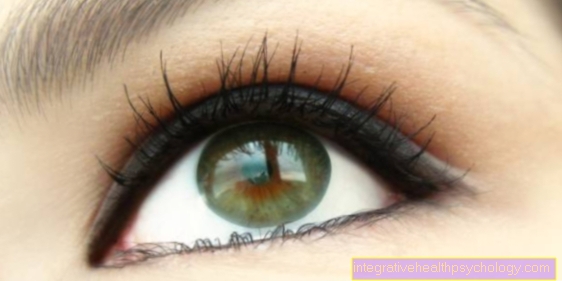Ethereal anesthesia
Definiton - what is ether anesthesia?
The ether anesthesia is considered to be the first form of anesthesia and thus represents the hour of birth of anesthesia. It was first used in 1842 by an American doctor.
Ether (also Diethyl ether) is a colorless chemical compound that is gaseous at room temperature.

This form of anesthesia is no longer used today due to its numerous side effects and the risk of the gas exploding.
Read more on the subject at: anesthesia
Is this still being used?
The ether anesthesia is no longer used nowadays because it has many undesirable side effects. Furthermore, ether is extremely flammable as a gas and can explode in the presence of oxygen.
Until a few years ago the use of ether as an anesthetic was still common in some developing countries, as it was a cheap alternative to other means. In 2005 the WHO removed ether from the list of indispensable drugs and ether is hardly available today.
You might also be interested in: Anesthetics
Until when was ether anesthesia used?
From its first use in 1846, ether was used regularly in America and Europe, despite some serious side effects. But justus Liebig had already discovered chloroform in 1831, which soon competed with ether.
Nevertheless, until a few years ago, ether anesthesia was an inexpensive alternative to other anesthetics, especially in developing countries. Nowadays, however, ether is hardly available and is no longer used.
Effect of ether anesthesia
In the past, a sponge was dipped into liquid ether for ether anesthesia and the gases then fed to the patient via a hose system. Even in small doses, ether switches off the processing of pain in the brain and inhibits muscle reflexes. In higher doses, ether first leads to a state of excitement and subsequently to apathetic states in which the patient can no longer be addressed.
Side effects of ether anesthesia
The side effects of ether anesthesia include above all nausea and vomiting after anesthesia, similar to a hangover after drinking alcohol. If the doses of ether are too high, the respiratory center can be paralyzed.
In the early days of ether anesthesia, there was often choking on vomit or saliva or an obstruction of the airway by the tongue. However, these complications occurred prior to the possibility of ventilation through intubation.
Another reason why ether anesthesia is no longer performed today is the long decay time after ether anesthesia and the poor controllability of the anesthesia.
You might also be interested in: Risks of anesthesia
History / inventor
The first documented ether anesthesia took place on March 30th, 1842 by the general practitioner Crawford Williamson Long. Previously, operations were performed without some form of anesthesia if necessary. However, Long did not report on his success.
On October 16, 1846, the dentist William Thomas Green Morton conducted a public demonstration with a surgeon under ether anesthesia. Morton is therefore considered to be the inventor of ether anesthesia and this day is the birthday of anesthesia.
In the further history of ether anesthesia, however, deaths from asphyxiation occurred again and again, as there was no way of securing the airway through intubation. It was not until World War II that it was customary to use a hose to keep the airway free.
Read more on the subject at: Intubation
However, shortly after its discovery, ether anesthesia faced competition from the chloroform discovered by Justus Liebig. In the 1960s, the ether was largely replaced by halothane as a gaseous anesthetic.
Recommendations from the editorial team
- anesthesia
- Aftermath of anesthesia
- Anesthetics
- general anesthetic

.jpg)












.jpg)














